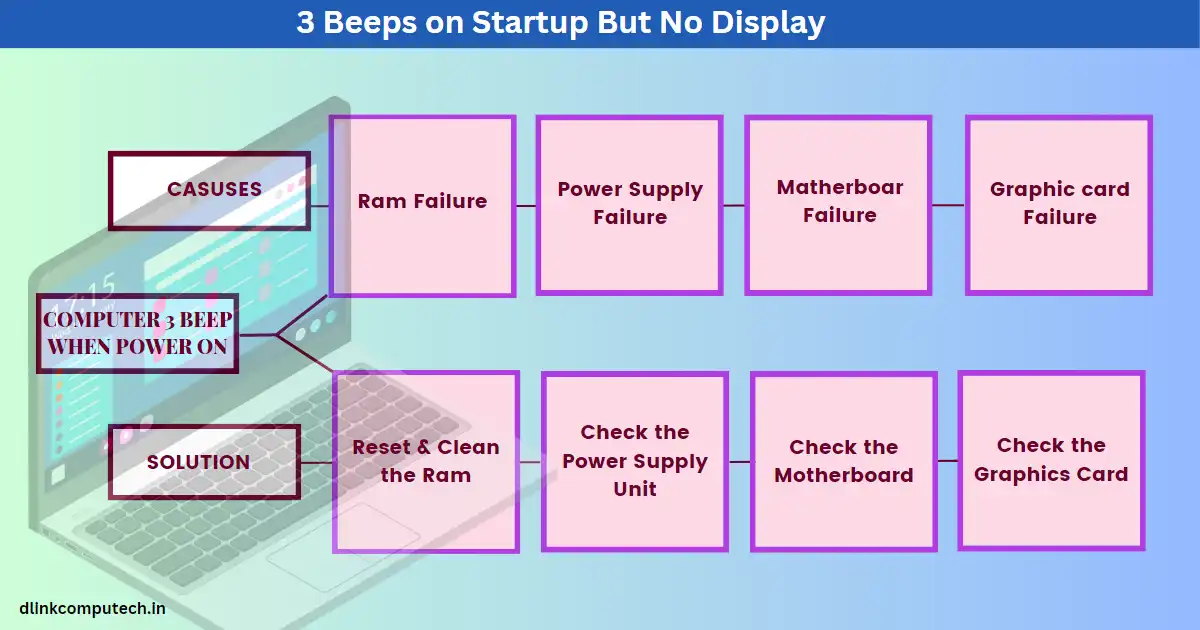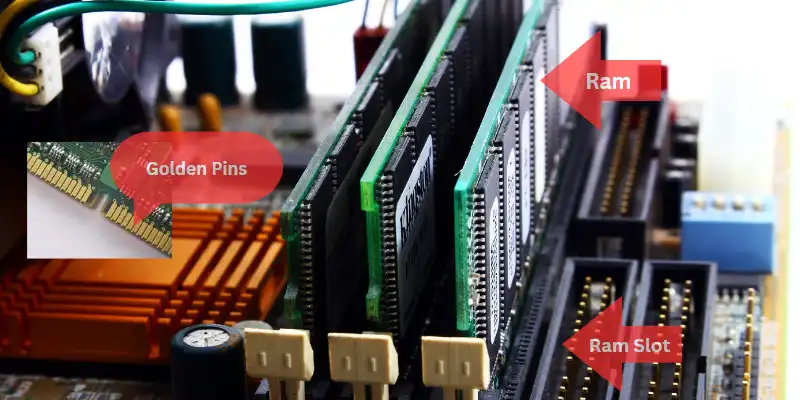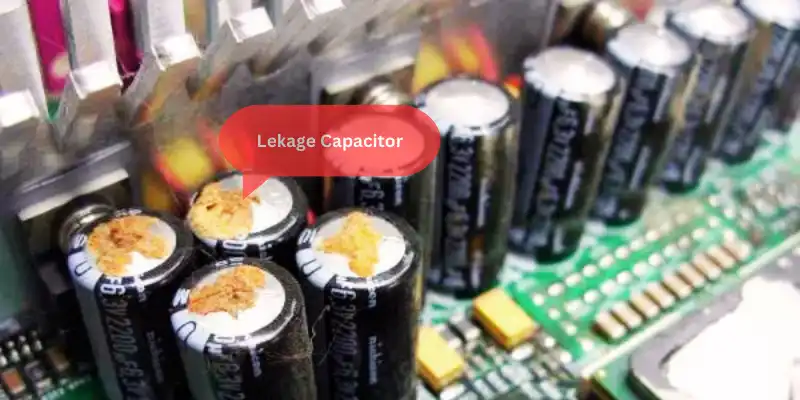If your computer makes three beeps when you turn it on but no display displays, you may have a serious problem. Three beeps indicate a hardware problem with the motherboard, RAM, or graphics card. This article investigates the probable reasons and remedies for this issue in your system.

Causes of 3 beeps on startup but no display
Before we get into the numerous causes of the three beeps at starting without a display, let’s look at why computers beep at startup in the first place. When you turn up your computer, it executes a Power-On Self-Test (POST) to ensure that all hardware components are working. If any of the components fail, the computer will beep to notify you of the problem.
The most usual reasons for a system beep at the startup are RAM failure, power supply faults, motherboard problems, graphics card problems, overheating, and BIOS.
Different beep codes can indicate various hardware issues. Here are some typical beep codes and what they mean:
Beep Code Description 1 Beep This Beep code indicates that everything is working correctly, and the machine is starting up normally. 2 Beep This can indicate a problem with the RAM (memory) in your computer. Remove and reseat the RAM to see if that resolves the issue. 3 Beep This usually indicates a memory or motherboard issue. Remove and reseat the RAM, and if that doesn’t work, replace it.
4 Beep This could suggest a problem with the video card or other hardware components. Try unplug and replug the video card, and if that does not work, replace it. Continues Beep This could suggest a problem with the power supply unit PSU or SMPS or the motherboard. Repair or replace the power supply first, not work, you may need to replace the motherboard. Note : It’s important to know that computer manufacturers can use different beep codes. As such, you should consult the manual with your computer or the manufacturer’s website for a list of unique beep codes for your Matherboard model.
Ram Failure
Your computer RAM is an important component that stores temporary data and allows your computer to access it fast. If your RAM is faulty, your computer will not boot properly, and you will hear three beeps on startup.
Power Supply Failure
The power supply unit PSU or SMPS of your computer is in charge of converting the alternating current AC from the wall outlet into the direct current DC that your computer requires to function. If your power supply dies, your computer will not boot and you will hear three beeps.
Motherboard Issues
The motherboard is the main board in your computer that connects all the other components together. If there is a problem with the motherboard, your computer would not start properly, and you’ll hear three beeps.
Graphic card Failure
The graphics card is in charge of displaying visuals on your monitor. If your graphics card fails, your computer will not be able to display any visuals and will emit three beeps at starting.
Fixing tips for Computer 3 Beeps on Startup But No Display
If you get three beeps on startup but no display, you can use the following troubleshooting steps to identify and resolve the issue:
Reset & Clean the Ram
First, Open your computer case and remove the RAM sticks. Then, reinsert them into the same slots or try different slots. Ensure that they are correctly seated and locked into place.
For troubleshooting you can follow these steps.
- Turn Off your computer Completly
- Open the computer case to have access to the inside parts
- Locate the RAM modules on your motherboard into Ram slots.
- Remove the RAM modules from their slots carefully.
- Use a soft cloth or rubber to clean the gold contacts Pin and dust on the bottom of the RAM modules.
- Put the RAM modules back in their slots. Check that they’re properly seated and securely locked in place.
- Close the PC case. Turn on the computer and see if the beeping continues or solve.
Note: If the beeping continues after completing these steps, one or more of your RAM modules may be failing. In this case, you must replace the damaged RAM module with a fresh one. You can try using one RAM module at a time ( if you have multiple modules ) to locate the problem module.

Check the Power Supply Unit
Second, ensure that your power supply is operational. Check that it is correctly linked to your computer and the electrical outlet. You can also try a different power outlet or cable to see if that helps.
For troubleshooting PSU or SMPS you can follow these steps.
- Open the computer case to have access to the inside parts
- Check the power supply cables inside the computer. Make sure all connections are properly seated and secured. This includes the motherboard power connector, the CPU power connector, and any additional power connectors for components such as graphics cards.
- Examine the power supply for any signs of physical damage, such as detached cables or inflated capacitors. If you discover any symptoms of damage, the power supply is going to require to be replaced.
- You can replace the existing power supply from another computer or a new one. This can help you evaluate whether the original power supply is defective.
If you are unsure or uncomfortable with these steps, get professional assistance.
Check the Motherboard
If reinstalling the RAM and power supply doesn’t solve the problem with your computer, you should examine the motherboard for any visible signs of damage. Look for things like bulging or leaking capacitors or burn marks. If you find any damage, you will need to replace the motherboard or repair it.

Check the Graphics Card
If your graphics card is separate from your motherboard, check it for signs of damage. Verify that it is properly attached to the motherboard graphic slot and that the power cords are properly plugged in.
Remove Dust and Clean the Computer
Overheating cause your computer to fail to boot properly. You may avoid this by frequently cleaning your computer and keeping it free of dust and debris. To remove dust from the fans, heatsinks, and vents, use a compressed air cleaner.
Update the Bios
If none of the previous methods fail to resolve the problem, you might try changing your BIOS. Download recent BIOS version from the motherboard manufacturer’s website. To upgrade your BIOS, follow the instructions.
If you are unable to identify and resolve the problem, you might seek professional help. Contact your computer maker or a trustworthy computer specialist for more advice.
Conclusion
In conclusion, three beeps on startup with no display is a common issue that can occur due to various reasons, such as RAM failure, power supply failure, motherboard issues, and graphics card failure. Regular maintenance, troubleshooting, and proper handling of your computer can prevent such issues. If you facing this issue try the above troubleshooting mentioned in this article, or seek a professional for more Advice.
FAQs
Why does my computer start up with 3 beeps?
When your computer boots up with three beeps, this indicates a hardware problem. The beeps are error codes generated by the BIOS of the computer at startup. The meaning of the three beeps varies depending on the brand and type of the computer. It is recommended that you examine your computer’s handbook or the manufacturer’s support resources to determine the specific reason for the sounds.
Can a virus cause three beeps on startup with no display?
No, a virus cannot cause this issue. It is a hardware problem.
What should I do if updating the BIOS does not solve the issue?
If updating the BIOS does not solve the issue, you need to replace the affected component or seek professional assistance.
Can a power surge cause three beeps on startup with no display?
Yes, a power surge can harm your computer’s components, resulting in this problem.
What should I do if the RAM is the problem?
Turn off and disconnect the computer from the power supply. Examine the computer chassis to ensure that the RAM is correctly inserted. Remove it and firmly reinsert it if it is loose. If the RAM is damaged replace new one.